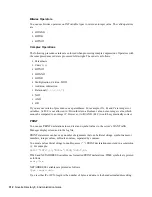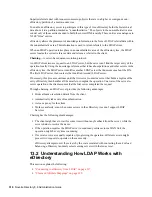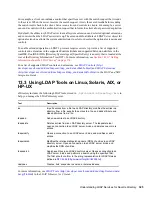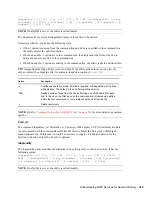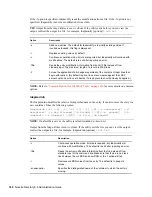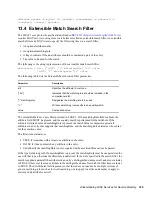
324
Novell eDirectory 8.8 Administration Guide
no
vd
ocx
(e
n)
6 Ap
ril 20
07
CN=JANEB,OU=MKTG,O=EMA
Some additional examples of LDAP distinguished names:
CN=Bill Williams,OU=PR,O=Bella Notte Corp
CN=Susan Jones,OU=Humanities,O=University College London,C=GB
Typeful Names
eDirectory uses both typeless (.JOHN.MARKETING.ABCCORP) and typeful
(CN=JOHN.OU=MARKETING.O=ABCCORP) names. LDAP uses only typeful names with
commas as the delimiters (CN=JOHN,OU=MARKETING,O=ABCCORP).
Escape Character
The backslash (\) is used in LDAP distinguished names as an escape character. If you use the plus
sign (+) or the comma (,), you can escape them with a single backslash character.
For example:
CN=PrCream,OU=Flavors,O=MFG (CN is PCream)
CN=DCardinal,O=Lionel\,Turner and Kaye,C=US (O is Lionel, Turner, and Kaye)
See Internet Engineering Task Force
RFC 232 (http://www.ietf.org/rfc/rfc2253.txt?number=2253)
for more information.
Multiple Naming Attributes
Objects can be defined with multiple naming attributes in the schema. In both LDAP and eDirectory,
the User object has two: CN and UID. The plus sign (+) separates the naming attributes in the
distinguished name. If the attributes are not explicitly labeled, the schema determines which string
goes with which attribute (the first would be CN, the second is UID for eDirectory and LDAP). You
can reorder them in a distinguished name if you manually label each portion.
For example, the following are two relative distinguished names:
Smith (CN is Smith CN=Smith)
Smith+Lisa (CN is Smith, the OU is Lisa CN=Smith UID=Lisa)
Both relative distinguished names (Smith and Smith+Lisa) can exist in the same context because
they must be referenced by two completely different relative distinguished names.
13.2.5 Supported Novell LDAP Controls and Extensions
The LDAP 3 protocol allows LDAP clients and LDAP servers to use controls and extensions for
extending an LDAP operation. Controls and extensions allow you to specify additional information
as part of a request or a response. Each extended operation is identified by an Object Identifier
(OID), which is a string of octet digits that are required to add an attribute or objectclass of your own
to an LDAP server. LDAP clients can send extended operation requests specifying the OID of the
extended operation that should be performed and the data specific to that extended operation. When
the LDAP server receives the request, it performs the extended operation and sends a response
containing an OID and any additional data to the client.
Summary of Contents for EDIRECTORY 8.8 SP2
Page 4: ...novdocx en 6 April 2007...
Page 116: ...116 Novell eDirectory 8 8 Administration Guide novdocx en 6 April 2007...
Page 128: ...128 Novell eDirectory 8 8 Administration Guide novdocx en 6 April 2007...
Page 255: ...256 Novell eDirectory 8 8 Administration Guide novdocx en 6 April 2007...
Page 406: ...408 Novell eDirectory 8 8 Administration Guide novdocx en 6 April 2007...
Page 563: ...566 Novell eDirectory 8 8 Administration Guide novdocx en 6 April 2007...
Page 573: ...576 Novell eDirectory 8 8 Administration Guide novdocx en 6 April 2007...
Page 601: ...604 Novell eDirectory 8 8 Administration Guide novdocx en 6 April 2007...



